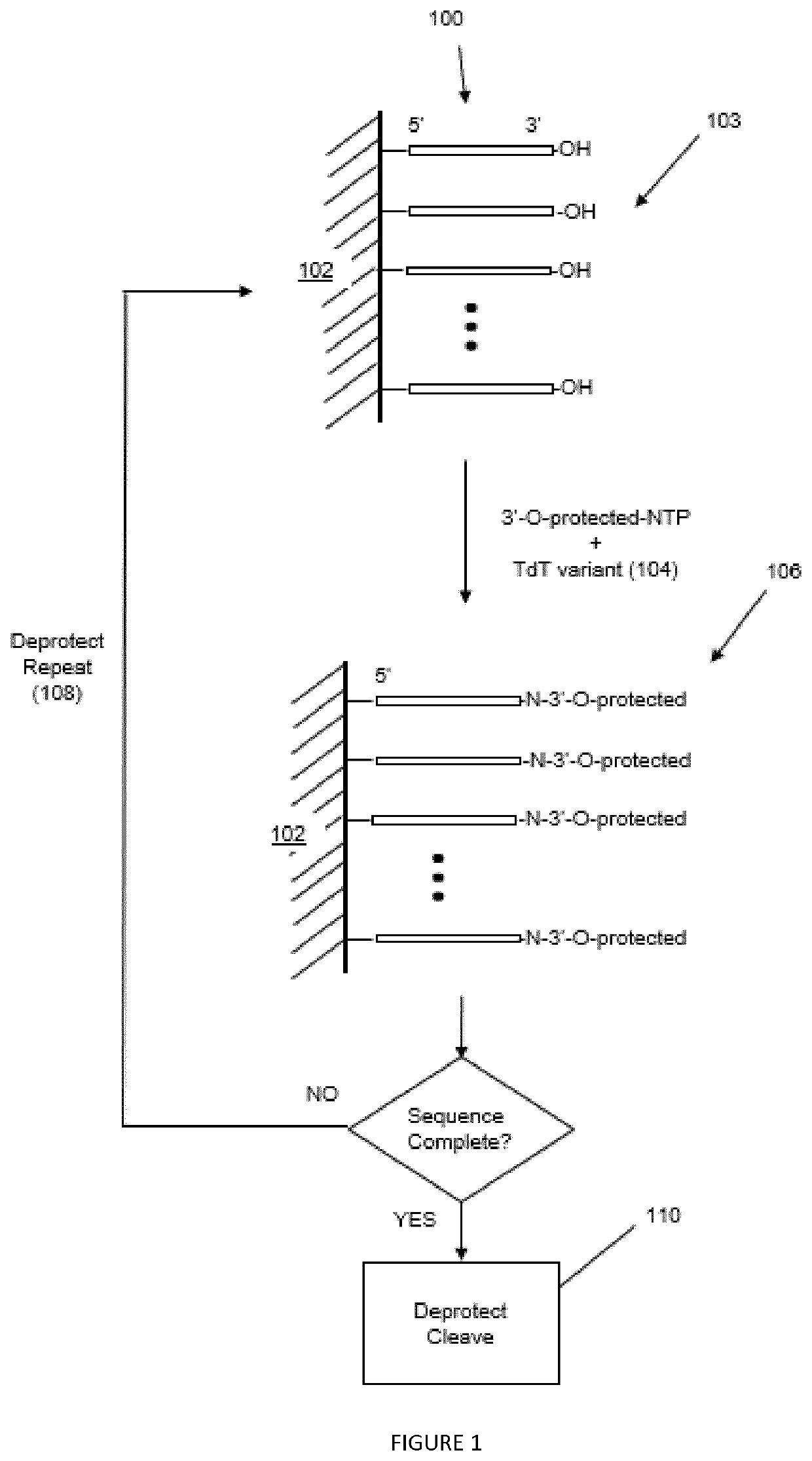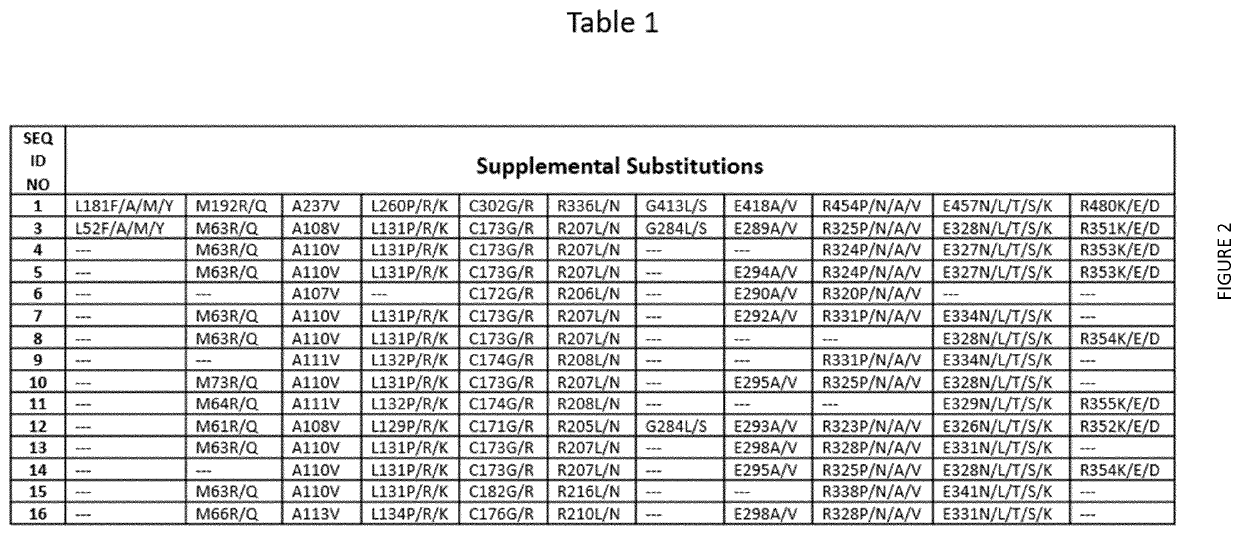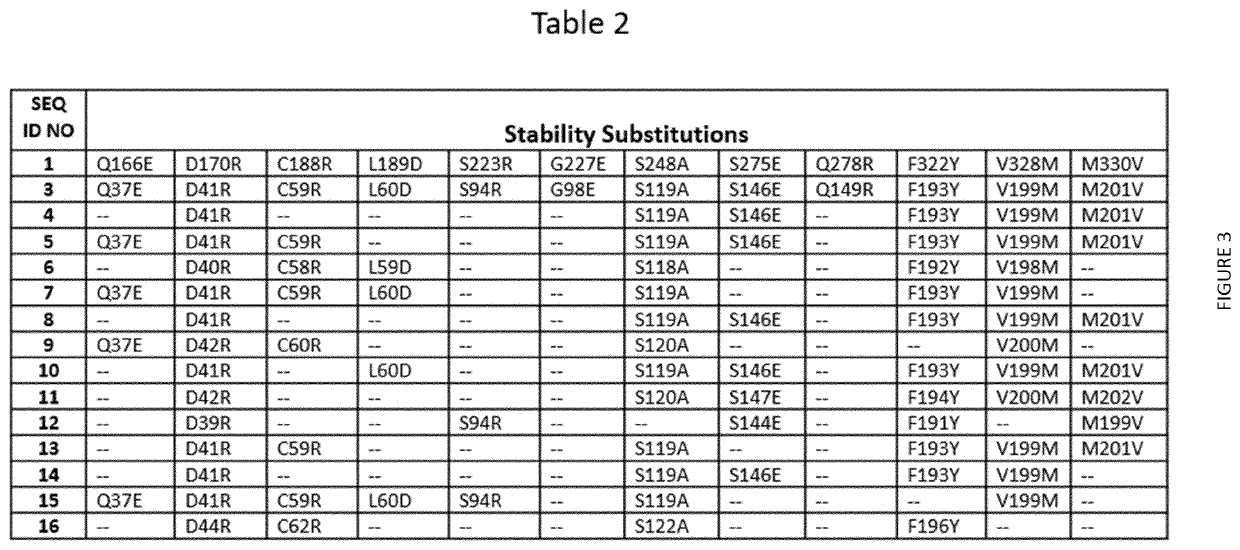Terminal Deoxynucleotidyl Transferase Variants and Uses Thereof
a technology of nucleotidyl transferase and terminal deoxynucleotidyl transferase, which is applied in the direction of transferases, enzymology, biochemistry apparatus and processes, etc., can solve the problems of greatly reduced efficiency of natural tdts incorporating such modified nucleoside triphosphates compared to unmodified nucleoside triphosphates, and achieves greater efficiency, higher rate, and stability
- Summary
- Abstract
- Description
- Claims
- Application Information
AI Technical Summary
Benefits of technology
Problems solved by technology
Method used
Image
Examples
example 1
n, Expression and Purification of TdT Variants
[0068]Expression strain generation. The TdT mouse gene may be generated from the pET28 plasmid described in [Boulé et al., 1998, Mol. Biotechnol. 10, 199-208]. For example, the gene may be amplified by using the following primers:
T7-pro:(SEQ ID No. 33)TAATACGACTCACTATAGGGT7-ter:(SEQ ID No. 34)GCTAGTTATTGCTCAGCGG
through standard molecular biology techniques. The sequence is then cloned into plasmid pET32 backbone to give the new pCTdT plasmid. After sequencing pCTdT is transformed into commercial E. coli cells, BL21 (DE3, from Novagen). Growing colonies on plate with kanamycin are isolated and named Ec-CTdT.Polymerase variants generation. The pCTdT vector is used as starting vector. Specific primers comprising one or several point mutations have been generated from Agilent online software (http: / / www.genomics.agilent.com:80 / primerDesignProgram.jsp). The commercially available kit QuickChange II (Agilent) may be used to generate the desire...
example 2
y of TdT Variants for Synthesizing Difficult Sequences
[0072]As noted above, the invention is based in part on a recognition and appreciation by the inventors that certain nucleotide sequences are difficult for TdTs to extend. Thus, an object of this experiment was to discover new TdT variants that exhibit enhanced capability to synthesize such difficult sequences based on comparison to an earlier TdT variant, designated M27 (SEQ ID NO: 32). In this example, a mutation library of mouse TdT (SEQ ID NO: 3) was produced based on structural information from mouse TdT, the activities of TdT variants from prior libraries, and from conventional protein engineering techniques. TdT variants from the library are expressed and purified as described above and were screened for their capability to synthesize certain difficult-to-synthesize sequences (shown in Table 7) at a higher rate than that of M27. Synthesis of the short sequences was performed by repeating 5 cycles of synthesis wherein each ...
example 3
nts of Various Species
[0074]In this example, non-mouse TdT variants were constructed from publicly available genes and were tested to determine their ability to incorporate 3′-O-amino-dNTPs into a test polynucleotide (p877) in hairpin completion assays as described above. The TdT variants are identified in Table 9 along with their incorporation capacity as compared to mouse TdT variant, M27.
TABLE 9Characteristics of Non-Mouse TdT VariantsPercentPercentActivityAccession NumberIdentityRelativeSEQSpeciesOf sources speciesto M27to M27*ID NOBovineNP_803461.18248427Related toXP_005999893.1803128LatmeriaPumaXP_026918530.1815429N139 reptilianXP_016851390.16813130ShrewXP_006880141.1825731Mouse M27100—32*Hairpin completion assay
Definitions
[0075]Amino acids are represented by either their one-letter or three-letters code according to the following nomenclature: A: alanine (Ala); C: cysteine (Cys); D: aspartic acid (Asp); E: glutamic acid (Glu); F: phenylalanine (Phe); G: glycine (Gly); H: hist...
PUM
| Property | Measurement | Unit |
|---|---|---|
| Fraction | aaaaa | aaaaa |
| Volume | aaaaa | aaaaa |
| Molar density | aaaaa | aaaaa |
Abstract
Description
Claims
Application Information
 Login to View More
Login to View More - R&D
- Intellectual Property
- Life Sciences
- Materials
- Tech Scout
- Unparalleled Data Quality
- Higher Quality Content
- 60% Fewer Hallucinations
Browse by: Latest US Patents, China's latest patents, Technical Efficacy Thesaurus, Application Domain, Technology Topic, Popular Technical Reports.
© 2025 PatSnap. All rights reserved.Legal|Privacy policy|Modern Slavery Act Transparency Statement|Sitemap|About US| Contact US: help@patsnap.com



